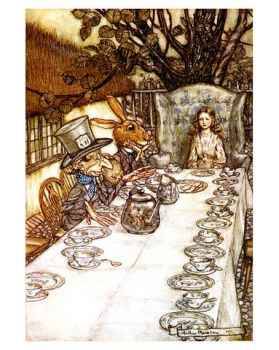When the Planning Committee decided that The Wizard of Oz was going to be the theme for our Girl Scout Association's Winter Camporee next year, I decided that someone on the planning team had better read the book because there was more to Oz than Kansas, the Emerald City, and Judy Garland.
So I bought one of the "literature" versions (i.e., inexpensive paperback) available at Barnes & Noble. It has a longish introduction about the Importance of This Book in Literature and footnotes. Footnotes? On Oz?
Apparently you can write a dissertation on just about anything... But I digress.
I'd forgotten that Dorothy's slippers were originally Silver Shoes. And the Wicked Witch of the West controlled the Winged Monkeys by wearing a Golden Cap and chanting the charm inscribed inside. And that Glinda the Good is a redhead.
Hmmm... I see a job for DD#1.
The Wizard of Oz was written by L. Frank Baum as the first fairy tale for American children. They would know about Kansas and the prairie and cyclones, as well as Scarecrows.
The book starts out with a description of Kansas--gray and flat. The sun has blistered the paint from the walls of the farmhouse and bleached and burned the grass. Even Aunt Em has turned gray. Dorothy is definitely not gray, due primarily to Toto, whose antics keep her laughing.
Although Dorothy's exact age is not mentioned in the text, from the pictures by W.W. Denslow and from Mr. Baum's comments, she is about five or six--still at an age where it's possible to believe--truly believe--in witches and wizards and fantastical worlds. As an only child, Dorothy is resourceful. After she has landed in Oz and finds out about the Wizard, she decides to go see him. But first she changes into a clean dress, puts on her sunbonnet, and packs food in a basket for herself and Toto. She follows the yellow brick road and comes across the Scarecrow, who was quite literally born yesterday. They discover the Tin Woodsman, who was originally a flesh-and-blood human man, in love with a real girl. He becomes tin piece-by-piece, due to the evil witch. And, of course, there is the Cowardly Lion.
Most of the chapters are short and the vocabulary simple, making this a good book for reading aloud or for a beginning reader. (There's a great story in Shirley Jackson's Life Among the Savages where her youngest daughter, Sally, discovers she can really read the Wizard of Oz.) In fact, The Wizard of Oz might also be a good book for older children who have difficulty reading, especially if they have some familiarity with the story.
However, there are notable differences between the book version and the movie. The movie has, for most of us, become the version from Ruby Slippers to "Pay no attention to the man behind the curtain!"
Besides there being a few more countries, Dorothy's journey is real in the book, not the by-product of a bump on the head. The Wicked Witch, the Scarecrow, the Tin Man, the Cowardly Lion, and the Wizard have no real life counterparts. The Good Witch of the North, a friend of the Munchkins, tells Dorothy the reason there are no witches in Kansas is because Kansas is "civilized country." And is there a child who hasn't looked at a china shepherdess or milkmaid and wondered what it would be like if the figurine were real? (Although that might have been more likely when Dresden figurines were more popular.)
Mr. Baum wrote 13 more books in the series and it was continued on after his death. I haven't read any of them, so I can't comment on the quality of those or if the internal logic of Oz remains consistent.
I read Wicked a couple of years ago and I was not particularly impressed. I might change my opinion after reading The Wizard of Oz--I didn't find anything particularly consistent between the two versions of Oz, other than the Wizard, Emerald City, and Glinda's name.
On the March Hare scale: 3.5 out of 5 Golden Bookmarks
Tuesday, April 24, 2007
Book Review: The Wizard of Oz
Posted by
March Hare
at
1:57 PM
![]()
Labels: Book Reviews
Subscribe to:
Comment Feed (RSS)




|